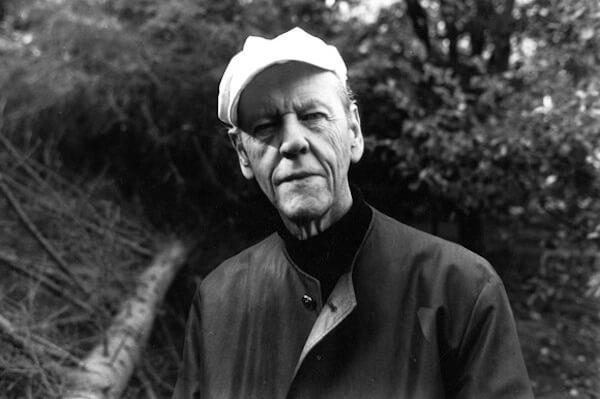![]() From Pythagoras’ hammers and Boethius’ musica mundana to Beethoven’s Pastoral and Strauss’ Alpensinfonie, composers, philosophers, and theorists have long mused on the relationship between the natural world and organized sound. Yet it was only beginning in the 1990s – and particularly since An Inconvenient Truth helped make climate change front page news – that pressing environmental issues really entered musical consciousness. Questions such as music’s role in attuning indigenous peoples to the land, the damage noise pollution causes to so-called “soundmarks,” and the character of harmonic and structural “landscapes”: all topics of considerable interest for “ecomusicology.” Thus it’s no coincidence that the ideas of composers like R. Murray Schafter, John Luther Adams, and Peter Schulthorpe have experienced something of a vogue in recent years, providing a framework to interpret musical phenomena as constituents of our ecosystem. Yet to this list should surely be added Vagn Holmboe (1909-96), the prolific Danish composer who characterized his idiosyncratic “metamorphosis” technique as something “that slowly seeps in through a life lived with nature.”
From Pythagoras’ hammers and Boethius’ musica mundana to Beethoven’s Pastoral and Strauss’ Alpensinfonie, composers, philosophers, and theorists have long mused on the relationship between the natural world and organized sound. Yet it was only beginning in the 1990s – and particularly since An Inconvenient Truth helped make climate change front page news – that pressing environmental issues really entered musical consciousness. Questions such as music’s role in attuning indigenous peoples to the land, the damage noise pollution causes to so-called “soundmarks,” and the character of harmonic and structural “landscapes”: all topics of considerable interest for “ecomusicology.” Thus it’s no coincidence that the ideas of composers like R. Murray Schafter, John Luther Adams, and Peter Schulthorpe have experienced something of a vogue in recent years, providing a framework to interpret musical phenomena as constituents of our ecosystem. Yet to this list should surely be added Vagn Holmboe (1909-96), the prolific Danish composer who characterized his idiosyncratic “metamorphosis” technique as something “that slowly seeps in through a life lived with nature.”

Holmboe, who always gave Copenhagen and Odense a wide berth, was a true environmentalist: over the years, he planted 3,000 trees on his countryside property. Musically, Holmboe’s concerns were typically abstract, though this didn’t prevent him from embarking late in life on a series of illustrative orchestral preludes, one of which is subtitled “To the Pollution of Nature.” Along similar lines, two sets of Kibkariuk, or “Inuit Songs” (Greenland is a dependency of Denmark), as well as a book-length study of Danish street cries, demonstrate his recognition that music structures our connection to the environment (whether rural or urban). The current disc, which provides a sampling of Holmboe’s wide-ranging chamber music, presents these concerns somewhat more obliquely. They come most strongly to the fore in the clarinet trio Eco – the title is meant in both senses, “echo” (not excluding the echolocation of animals) as well as the prefix “eco-” – written concurrently with the above-mentioned preludes. In common with all the works included here, the dissonance level is low: Eco eschews what Holmboe derided as compositional “tricks,” in favor of a discursive, conversational stream of constant motivic transformation. (Here the starting point is a “Hungarian” augmented second-plus-minor second figure). Though the work is, if anything, much too short – musical conservationism in action? – Eco is nevertheless highly satisfying on its own terms, with the arabesques and false relations of the third movement introduction but one highlight among many. Eco is also extremely grateful for the instrumentalists; it would make an apt coupling with the Brahms Clarinet Trio.
 Also startlingly concise is the Sextet, written for the unusual combination of flute, clarinet, bassoon, violin, viola, and cello. The style is more conspicuously “neoclassical” here, though sudden bursts of rowdy fiddling prevent the proceedings from becoming too staid. There follows a slow movement of ravishing rustic lyricism and a perky scherzo-finale – neither of which you would ever guess were written as late as 1973, the year of Music in Twelve Parts and Des canyons aux étoiles…. Yet there’s something quite attractive about the music’s reticence, its staunch refusal to outstay its welcome by even a second. Even Aspekter, probably the most ambitious piece on the disc, weighs in at barely over fifteen minutes. Written for wind quintet, the shadow of Nielsen’s Op. 43 looms large over the proceedings. Though Holmboe doesn’t escape what Theodor Adorno memorably described as the “culinary” trappings of the wind quintet medium any more than did his forebear and compatriot, Aspekter is considerably bolder than Eco in its use of “metamorphoses.” Over the course of five movements, a horn motto evolves into all manner of new forms, from a syrupy, French-sounding chorale to an almost Sibelian modal lament and a jaunty, outdoorsy dance. How Holmboe gets from Point A to Point B isn’t always clear on first listening, but then again, it’s not meant to be: as Holmboe himself once described it, his music is “the reflection of an order which is in itself unfathomable and impossible to form – like the structure of atoms, or the galaxies of the universe.”
Also startlingly concise is the Sextet, written for the unusual combination of flute, clarinet, bassoon, violin, viola, and cello. The style is more conspicuously “neoclassical” here, though sudden bursts of rowdy fiddling prevent the proceedings from becoming too staid. There follows a slow movement of ravishing rustic lyricism and a perky scherzo-finale – neither of which you would ever guess were written as late as 1973, the year of Music in Twelve Parts and Des canyons aux étoiles…. Yet there’s something quite attractive about the music’s reticence, its staunch refusal to outstay its welcome by even a second. Even Aspekter, probably the most ambitious piece on the disc, weighs in at barely over fifteen minutes. Written for wind quintet, the shadow of Nielsen’s Op. 43 looms large over the proceedings. Though Holmboe doesn’t escape what Theodor Adorno memorably described as the “culinary” trappings of the wind quintet medium any more than did his forebear and compatriot, Aspekter is considerably bolder than Eco in its use of “metamorphoses.” Over the course of five movements, a horn motto evolves into all manner of new forms, from a syrupy, French-sounding chorale to an almost Sibelian modal lament and a jaunty, outdoorsy dance. How Holmboe gets from Point A to Point B isn’t always clear on first listening, but then again, it’s not meant to be: as Holmboe himself once described it, his music is “the reflection of an order which is in itself unfathomable and impossible to form – like the structure of atoms, or the galaxies of the universe.”
As for the Sonata for Violoncello Solo, comparisons will inevitably be made with Kodály and Ligeti, and although Holmboe actually went folksong collecting in Romania during his student years, in reality the work partakes of less paprika-scented exhibitionism than you might expect. No doubt, as in Eco, there’s an Eastern European tint to the melodic turns of phrase, but they’re put to rather understated ends: all here is ruminative soliloquizing. This is clearest in the gorgeous artificial harmonics melodies of the third movement introduction, which inadvertently put one in mind of George Crumb (who also, like Ligeti, wrote an early unaccompanied cello sonata). Enterprising cellists would do well to check the piece out. Finally, there’s the Quartetto Medico, so named because it was written for a group of MDs who moonlighted as amateur musicians. Notwithstanding its droll movement titles – these include “Andante senza pianisticitis” – this is the least interesting piece on the disc. Nevertheless, it provides ample demonstration to Holmboe’s commitment to providing “music for use”.
It’s this last point that has led more than one commentator to describe Holmboe as a modern-day Haydn – a moniker Holmboe thoroughly relished. Never flashy or loose-lipped, his music always eschews ersatz emotional catharsis. It’s sturdy and old-fashioned, like a well-made chair: for all you know, Holmboe lived in a bubble, and Boulez, Cage, and Reich might as well have never existed. Returning to the ecological-geographical theme, I can’t put it any better than Richard Taruskin:
“In the twentieth century, the symphony moved to the suburbs. Just as the Scandinavian welfare democracies have always offered an unglamorous, easily despised counterexample to romanticists of the right and left, so the remarkably tenacious and productive Scandinavian symphonic tradition, though easily ignored as ‘regional,’ looks mighty healthy amid all the epic train wrecks now littering the modernist landscape.”
Taruskin’s point, though made with regard to Holmboe’s orchestral music, is just as applicable to the ever-pleasing, always-resourceful, self-deprecating chamber works featured on this disc. And while most of these pieces aren’t too taxing from a technical standpoint, it’s clear on the basis of the performances that the Ensemble MidtVest has no qualms as to their value. In sum: for those with an interest in the “burbs” of twentieth-century music, Dacapo’s disc will provide much enjoyment.
Vagn Holmboe, Chamber Music (II) (Dacapo 8.226074, October 2012) | Buy it on Amazon US, Buy it on Amazon UK
–
Matt Mendez is an independent musicologist and critic. His personal blog is http://soundproofedblog.blogspot.com.
























